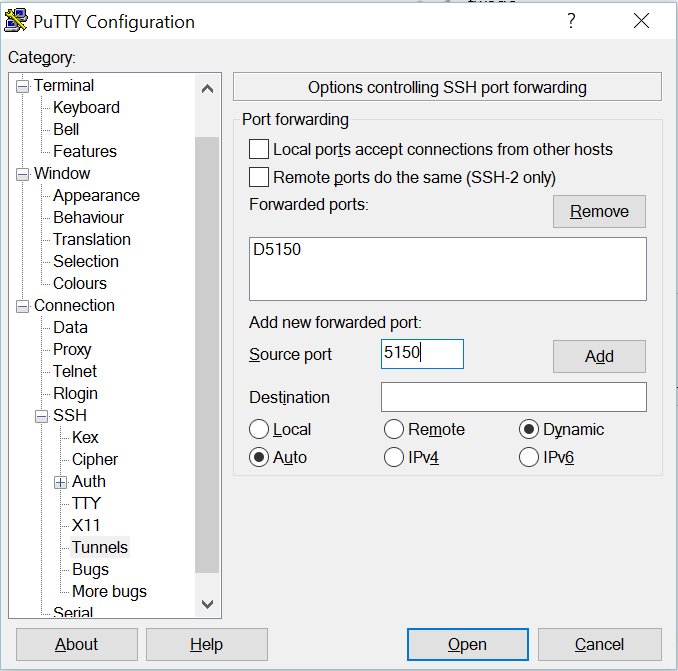

- Python3 ssh proxy how to#
- Python3 ssh proxy install#
- Python3 ssh proxy manual#
- Python3 ssh proxy full#
If you are running a Postgres instance locally, then it will probably already be using

Likewise: ssh -L 5432::10123 -L option means "forward LOCAL port 5432 to REMOTE host On the "Postgres" tab of the "Databases" page, and changing the hostname from Username with your PythonAnywhere username, 10123 with the port number (that is, on your own machine - not on PythonAnywhere) like this, replacing If you're using Windows, see the "Using PuTTY on Windows"Īs long as you're not running a Postgres instance locally, just invoke SSH locally If you're using a Mac or Linux, you probably already have the Running on your machine but actually sends data over SSH to your PythonAnywhere
Python3 ssh proxy manual#
Manual SSH tunnelling ¶įor other tools that you want to run on your own machine, you can set up a tunnel that pretends to be a Postgres server If you're getting intermittent connection errors, try increasing one or both of If you have trouble with the SSH Tunnel connection, the project provides a This example uses the psycopg2 library, but you can use any Postgres local_bind_port, database = 'your database name', ) # Do stuff connection. connect ( user = 'a postgres user', password = 'password for the postgres user', host = '127.0.0.1', port = tunnel. ', the port on the databases page ) ) as tunnel : connection = psycopg2. SSHTunnelForwarder ( ( '' ), ssh_username = 'your PythonAnywhere username', ssh_password = 'the password you use to log in to the PythonAnywhere website', remote_bind_address = ( 'your PythonAnywhere database hostname, eg.
Python3 ssh proxy install#
Your Postgres database, you can install the sshtunnel packageĪnd then use code like this: import psycopg2 import sshtunnel sshtunnel. If you're running Python code on your local machine, and you want it to access If you're using TablePlus, you can use the settings from this diagram provided by Then you should be able to connect from pgAdmin to your PythonAnywhere Postgres Sure to use the correct port in the next step.Īnd give the connection a name on the "General" tab, then set up the stuff on theĪny user you have set up on your Postgres server, eg. You can try any other port number greater than 1024 and less than 65536. If that doesn't work because you get an error like: cannot listen to port: 9999 The local side of your SSH tunnel will be at port 9999. As long as that SSH session is active, your SSH tunnel When this has worked, it will appear that you have SSHed into your

The port from the Postgres tab of the "Databases" page inside PythonAnywhere Your PythonAnywhere database hostname, eg. Tunnel from your machine to PythonAnywhere and then connect to the local portįirst, we create the SSH tunnel: ssh -4 -L 9999:postgres-server-hostname:postgres-server-port you should: replace If you're running pgadmin, you can use SSH in a local terminal to create an SSH There are a number of ways to do this: pgAdmin ¶ If you're using our EU-hosted site at eu., then the.If you're using our global, US-hosted site at then the.However, if you have a paid account, you can access your databaseįrom outside using a technique called an SSH tunnel, which essentially makesĪ secure SSH connection to our systems, then sends the Postgres stuff over it.

PostgreSQL databases on PythonAnywhere are protected by a firewall, so external All Rights Reserved.Warning - this will only work in paid accounts # Your application is now connected to an SSH server # through a SOCKS4 or SOCKS5 proxy. # Connect to an SSH server via a SOCKS proxy: # Hostname may be an IP address or hostname:
Python3 ssh proxy full#
# SOCKS5 servers support full login/password authentication. # Note: SOCKS4 servers only support usernames without passwords. # Set the SOCKS version to 4 or 5 based on the version # of the SOCKS proxy server: # To use a SOCKS4 or SOCKS5 proxy, simply set the following # properties prior to connecting: # The SOCKS hostname may be a domain name or # IP address: # See Global Unlock Sample for sample code. # This example assumes the Chilkat API to have been previously unlocked. Raspberry Pi and other single board computers Python Module for Windows, Linux, Alpine Linux,
Python3 ssh proxy how to#
Demonstrates how to connect to an SSH server through a SOCKS4 or SOCKS5 proxy.


 0 kommentar(er)
0 kommentar(er)
